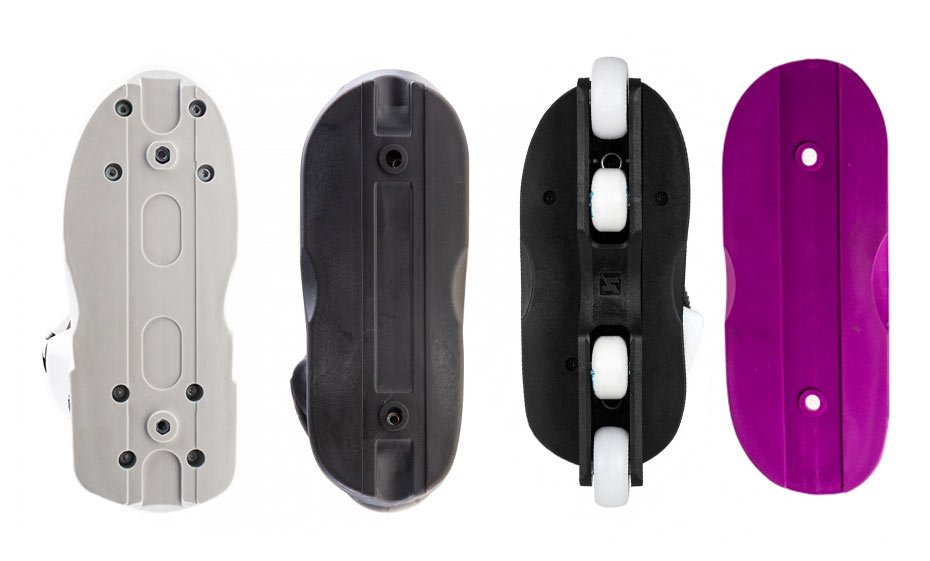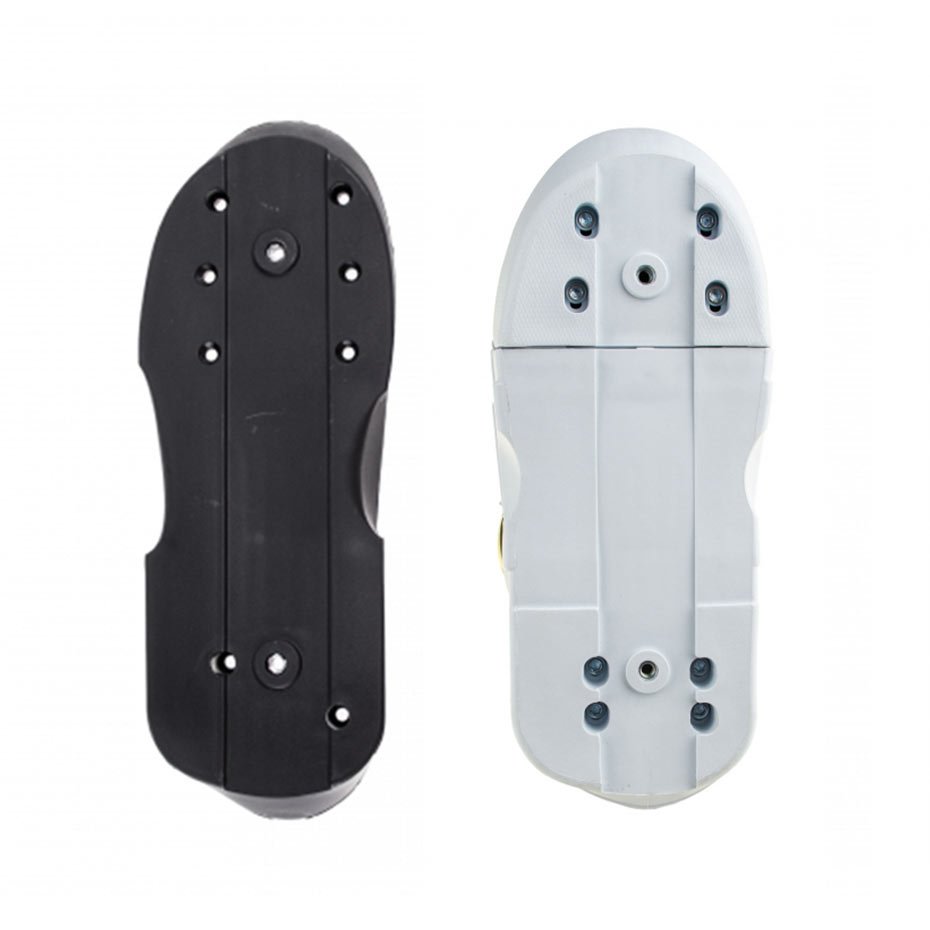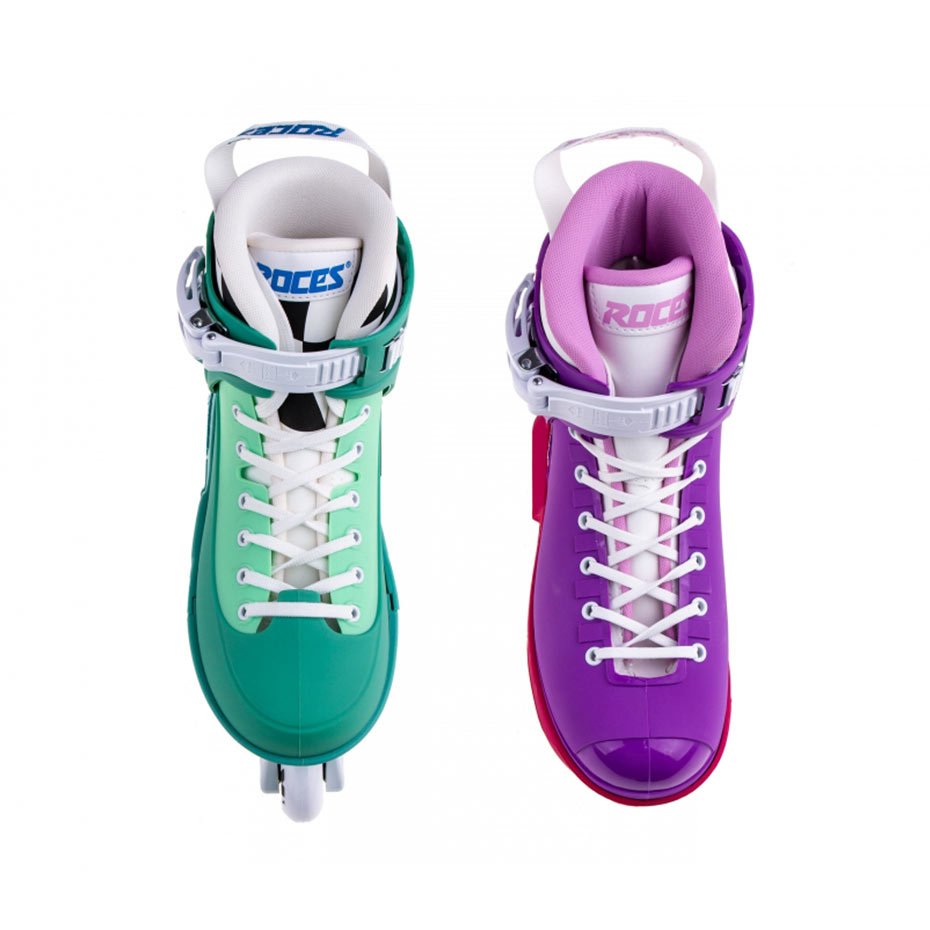An essential component in aggressive skates, the soul plate is typically flat or gently curved and is affixed to the underside of the skate's shell. Its purpose is to facilitate the execution of tricks known as grinds, extending seamlessly from the front to the back of the skate. Usually made of durable and slippery plastic (of various types). The main function of the soul plate is to reduce friction and protect the skate shell from wear and tear. It provides a smooth and slippery surface that allows the skater to perform tricks on ledges or on a rail. Moreover, the versatility of soul plates allows skaters to personalize and interchange them according to their preferences, with various designs offered by different skate brands to cater to individual styles and requirements.
In this blog entry, we aim to address a frequently pondered question among inline skaters regarding the impact of soul plate size. Does opting for larger soul plates truly enhance trick performance? What advantages can be gained, and what limitations might a wider soul plate impose during practice?
To comprehend the significance of soul plate size, let's trace back to the origins of aggressive inline skates in the early 90s. Initially, these skates inherited a minimalistic soul system, rendering them ill-suited for executing lengthy grinds. Essentially, early aggressive models were derived from basic inline skates, lacking dedicated additional components to maximize contact with grinded surfaces. However, the evolution of trick trends compelled manufacturers to swiftly respond, leading to the emergence of products that facilitated trick execution.
The initial iterations of aggressive inline skates consisted of shells with raised heels, consequently giving rise to non-flat soul plates.
The ergonomic design of inline skate shells allotted more maneuvering space for tricks at the front, prompting the initial expansion of the heel size through the use of specialized blocks referred to as heel plates.
A groundbreaking revolution arrived with the introduction of the Roces soul plate in subsequent iterations of the iconic M12 model. Unlike its predecessors, this soul plate spanned the entire length of the shell, providing comprehensive protection and enabling more stable and prolonged soul grinds. However, it was the K2 Fatty, an aggressive inline skate model well ahead of its time, that ushered in a momentous transformation by introducing a completely straight soul plate, revolutionizing the game.
As the evolution of soul plates progressed, it became evident that larger sizes were not always advantageous, but rather had the potential to impede performance. A notable case highlighting this observation was the infamous Widebody by Salomon. In an attempt to retain its market position, Salomon introduced an interchangeably soul plate of unnaturally large size, aiming to excel in the hardware race. Unfortunately, the outcome was far from what was intended. Salomon's previously respected sleek and compact skates transformed into bulky behemoths. While the oversized soul plates may have made certain soul tricks slightly easier, they compromised the distinctive 'feel' of these skates, particularly during royale tricks. This misstep ultimately became the final blow to the Salomon brand, tarnishing its reputation within the aggressive skating community.
Another peculiar experimentation with soul plate size was evident in the USD Legacy models. The venture marked by innovation. The base, also known as the soulframe, allowed for the adjustment of soul plate size by enabling placement in various positions. However, when extended to its maximum limit, the resulting unnaturally wide soul plate, while potentially aiding beginners in soul grinds, posed hindrances during casual flat skating. The Legacy design was swiftly discontinued after only a few editions.

When it comes to discussing inline skates with an impressively large soul plate size, we must also acknowledge the initial Xsjado models. They boasted the most extensive grind surface among aggressive skate models. Xsjado skates were designed from the outset with a wide base plate that seamlessly complemented the entire structure. This integration worked in harmony with the innovative Mook inline skate frame, achieving the desired effect. The first Xsjado skates aimed to be a completely fresh concept, and their distinct qualities garnered a considerable following. The wide soul kits were well-received, but new trends were emerging, altering the skaters' requirements once again.
Following 2005, the blading scene experienced a notable shift towards rock 'n' roll vibes, which brought about significant changes in both trick styles and fashion trends. Skaters began favouring tighter pants, and the skates themselves underwent a gradual transformation, becoming sleeker and visually smaller. The once massive Razors, filled with additional tongues, were boldly replaced by the compact USD Carbon or the timeless Roces M12, which made a comeback. The focus shifted from technical handrail tricks to creative skating on original obstacles, diminishing the importance of giant soul kits. Suddenly, as we watched Alex Broskow's impressive performances with the M12, many of us realized that the size of our soul plate wasn't the most crucial factor. The control and responsiveness offered by streamlined inline skates became vital considerations when selecting our equipment.

With time, manufacturers have reached a balance, offering soul plates of optimal sizes to cater to different preferences. While the size differences themselves are no longer as stark, the unique shape of a particular manufacturer's soul plate can still define their characteristics. If you prefer skates with consistent soul plate width throughout the entire shell length, models like USD Aeon, USD Carbon, or USD Sway would suit you well. However, if you've been grinding for years and are accustomed to a “toe-heavy” (placing body weight on the front of the skate) style from the original M12s, you might find soul plates with a slightly larger front section and a slightly reduced heel area more to your liking, such as the Themskates 909 or Seba CJ.

The choice ultimately boils down to personal preference, so to make things easier, we've categorized the features of currently available soul plates into two groups:
Who benefits from a large soul plate?
- Skaters tackling harder, steeper handrails can benefit from a large soul plate. The increased friction provides more control during grinds. A prime example is Chris Farmer, known for his love of massive, albeit slower, soul plates like those found on Xsjado/USD Shadow skates. He achieved incredible feats on challenging kinked rails with these
- Wide soul plates make cess slide tricks easier. The extended soul plate reduces the required angle to place the entire skate “sideways” on the ground. It becomes effortless to position the skate so that the soul plate and bottom edge of the frame touch the ground simultaneously, allowing for smooth cess slides with minimal effort.
- a far sticking out royal groove in a soul plate with a larger surface area, will significantly reduce the angle needed for a decent lock of Royale tricks (one of the basic rail grinds). This will be particularly noticeable on slightly taller frames with 64 mm wheels upwards.
- Topside tricks will be easier to 'hit' however they definitely require a lot more bending.
- Larger soul plates aid in executing negative tricks. Even a slight increase of 0.5 CM on the inside can help negative tricks securely “lock on” to the obstacle.
- Soul plates with a generous surface area often feature additional screws connecting them to the shell, as seen in skates like Gawds or USD Sway. This enhances responsiveness, providing a more direct connection between the skater and the skate.
- Beginners benefit from large soul plates as well. Your initial attempts at soul grinds will be easier on skates like USD Shadow compared to, for example, Roces M12. These larger soul plates offer a greater margin for error, facilitating the learning process.

Who benefits from a smaller, compact soul plate?
- Bladers who frequent skate skatepark transitions will appreciate the advantages of a compact, slim soul plate. When swiftly changing direction on ramps or landing from higher heights, there is no risk of the extended soul plate catching on the surface. This ensures stability and maintains control throughout the movements.
- A smaller soul plate offers noticeably faster grinds. If you enjoy grinding smoothly over well-waxed ledges, a slightly smaller soul plate will effectively lengthen your grinds, providing a more satisfying experience.
- Inline skates equipped with a smaller, thinner soul plate offer enhanced responsiveness. The key factor here is the distance between the foot and the surface being grinded. While a larger soul plate may make tricks easier, mastering them on a slightly smaller soul plate ensures a 100% understanding and proficiency. Once mastered, you will encounter fewer difficulties performing these tricks in the future.

If we are beginners, it is a good idea to focus on learning the basic techniques and improving our skills on the equipment we have. Regardless of the width of the soul plate, we will be able to understand basic aggressive inline tricks such as jumps and grinds. It is these skills that will be key when we decide to go for more specialized equipment.
However, once we have gained confidence and feel comfortable jumping on tricks, we can start experimenting with different types of soul plates. If you prefer rail grinds, a narrow soul plate will provide more freedom and precision. On the other hand, if we prefer grinds on ledges and different surfaces, a wider soul plate can give us more stability and balance.
In conclusion, when choosing your first skates for aggressive inline skating, it is not worth bothering too much about the width of the soul plate. You can learn to skate with any equipment, and what really matters is our preferred riding style and where we intend to session.

























